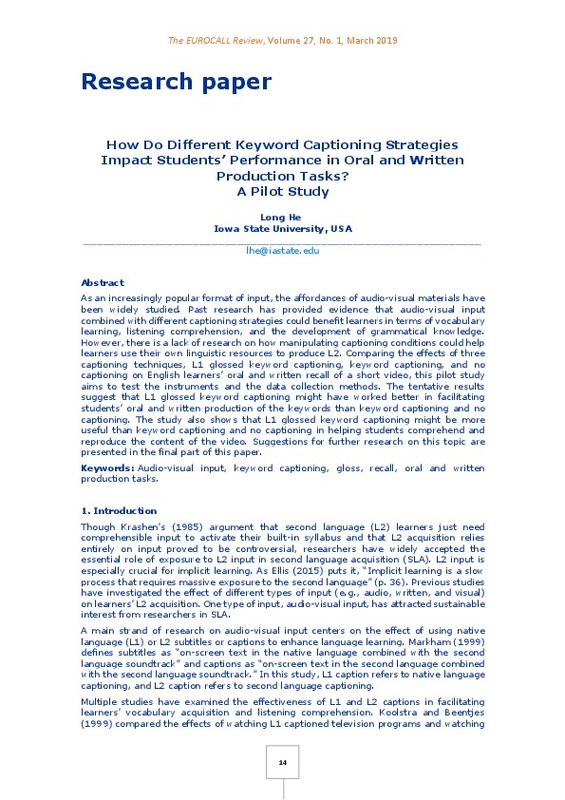Anthony, L. (2014). AntWordProfiler (Version 1.4.1) [Computer Software]. Tokyo, Japan: Waseda University. Available from http://www.laurenceanthony.net/software.
Ellis, R. (2015). Understanding Second Language Acquisition (2nd Ed.). Oxford: Oxford University Press.
Ellis, R. (2018). Reflections on task-based language teaching. Bristol: Multilingual Matters. https://doi.org/10.21832/9781788920148
[+]
Anthony, L. (2014). AntWordProfiler (Version 1.4.1) [Computer Software]. Tokyo, Japan: Waseda University. Available from http://www.laurenceanthony.net/software.
Ellis, R. (2015). Understanding Second Language Acquisition (2nd Ed.). Oxford: Oxford University Press.
Ellis, R. (2018). Reflections on task-based language teaching. Bristol: Multilingual Matters. https://doi.org/10.21832/9781788920148
Guillory, H. G. (1998). The Effects of Keyword Captions to Authentic French Video on Learner Comprehension. CALICO Journal, 15(1-3), 89-108. https://doi.org/10.1558/cj.v15i1-3.89-108
Koolstra, C. M. & Beentjes, J. W. J. (1999) Children's vocabulary acquisition in a foreign language through watching subtitled television programs at home. Educational Technology, Research and Development, 47(1): 51-60. https://doi.org/10.1007/BF02299476
Krashen, S. D. (1985). The Input Hypothesis: Issues and Implications. New York: Longman.
Lee, M. & Révész, A. J. (2018). Promoting Grammatical Development through Textually Enhanced Captions: An Eye-Tracking Study. Modern Language Journal. https://doi.org/10.1111/modl.12503.
Long, M. H. (1983). Native speaker/non-native speaker conversation and the negotiation of comprehensible input. Applied Linguistics, 4, 126-141. https://doi.org/10.1093/applin/4.2.126
Markham, P. L. (1999). Captioned videotapes and second-language listening word recognition. Foreign Language Annals, 32(3), 321-328. https://doi.org/10.1111/j.1944-9720.1999.tb01344.x
Markham, P. L., Peter, L. A. & McCarthy, T. J. (2001). The effects of native language vs. target language captions on foreign language students' DVD video comprehension. Foreign Language Annals, 34(5): 439-445. https://doi.org/10.1111/j.1944-9720.2001.tb02083.x
Montero Pérez, M., Peters, E. & Desmet, P. (2018). Vocabulary learning through viewing video: The effect of two enhancement techniques. Computer Assisted Language Learning, 31(1-2), 1-26. https://doi.org/10.1080/09588221.2017.1375960
Montero Pérez, M., Peters, E. & Desmet, P. (2014). Is less more? Effectiveness and perceived usefulness of keyword and full captioned video for L2 listening comprehension. ReCALL, 26(1): 21-43. https://doi.org/10.1017/S0958344013000256
Nation, P., & Beglar, D. (2007). A vocabulary size test. The Language Teacher, 31(7), 913.
Nava, A., & Pedrazzini, L. (2018). Second language acquisition in action: Principles from practice. London; New York, NY: Bloomsbury Academic.
Nguyen, C. D. & Boers, F. (2018). The Effect of Content Retelling on Vocabulary Uptake from a TED Talk. TESOL Quarterly, 52 (1), 1-25. https://doi.org/10.1002/tesq.441
Riley, G. L., & Lee, J. E. (1996). A comparison of recall and summary protocols as measures of second language comprehension. Language Testing, 13(2), 173-98. https://doi.org/10.1177/026553229601300203
Rodgers, M.P.H. & Webb, S. (2017). The Effects of Captions on EFL Learners' Comprehension of English-Language Television Programs. CALICO Journal, 34(1), 20-38. https://doi.org/10.1558/cj.29522
Schmidt, R. (2001). Attention. In Robinson, P. (ed.): Cognition and Second Language Instruction. Cambridge: Cambridge University Press, pp. 3-32. https://doi.org/10.1017/CBO9781139524780.003
Swain, M. (1985). Communicative competence: Some roles of comprehensible input and comprehensible output in its development. In S. Gass &C. Madden (Eds.), Input in second language acquisition (pp. 235-253). Massachusetts: Newbury House.
Winke, P., Gass, S., & Sydorenko, T. (2010). The effects of captioning videos used for foreign language listening activities. Language Learning & Technology, 14(1). 65-86.
[-]








